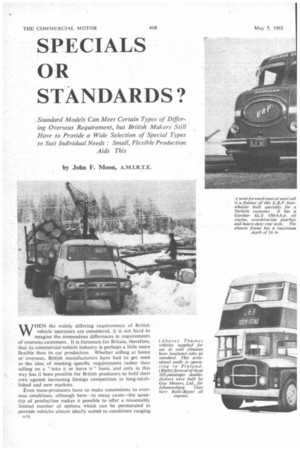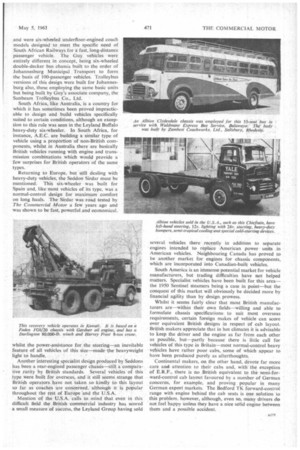SPECIALS OR STANDARDS?
Page 132

Page 133

Page 134

Page 135

If you've noticed an error in this article please click here to report it so we can fix it.
WHEN the widely differing requirements of British vehicle operators are considered, it is not hard to imagine the tremendous differences in requirements of overseas customers. It is fortunate for Britain, therefore, that its commercial-vehicle industry is-perhaps a little more flexible than its car production. Whether selling at home or overseas, British manufacturers have had to get used to the idea of meeting specific requirements rather than• selling on a "take it or leave it" basis, and only in this way has it been possible for British producers to hold their own against increasing foreign competition in long-established and new markets.
Even mass-producers have to make concessions to overseas conditions, although here—in many cases—the quantity of production makes it possible to offer a reasonably limited number of options which can be permutated to provide vehicles almost ideally suited to conditions ranging from arctic to tropical, and from dirt roads to motorways.
Nevertheless, " specials " have been very much a part of the British commercial-vehicle industry for many years, and will obviously continue to be so for some time to come. Whilst certain recent designs have shown that it is possible to effect a reasonable compromise towards meeting home and overseas conditions in one basic vehicle, British and overseas _conditions can be so unalike as to produce the dangerous condition whereby such a vehicle could be suited to neither market.
Continental and American manufacturers are possibly more fortunate in this respect in that their home and overseas conditions are sometimes more similar, and certain of these manufacturers will not make concessions to individual requirements. This being the case, and assuming that
the operator in question sticks to his guns, the more flexible British manufacturer can possibly step in and secure an order, always assuming that it is worth his while to go to the expense of possibly evolving a completely new design with the risk of only a limited demand.
Whilst there are some small-quantity manufacturers who very rarely seem to get the chance to build even two identical vehicles for export. mass-production concerns building lightand medium-weight vehicles have been able to build and sell overseas appreciable quantities of virtually standard vehicles, sales territories including that most difficult of all areas for British manufacturers—the European mainland.
A good example of this "mass production-cum-specialization " is provided by the Ford Motor Co., whose Thames Trader range was designed with world-wide sales in mind, and whose list of production options includes-most of the special equipment likely to be required by operators in overseas territories.
Insulated Cabs for Europe
Traders sold in Northern Europe are supplied with special cold-starting equipment and insulated cabs, whilst, in common with all Ford vehicles exported, larger tyres are supplied than would be needed in Britain. Regarding Northern Europe, Ford's have found that extra-long wheelbase vehicles are popular in Finland, as a result of which many of the vehicles sold in that country have Baico chassis extensions.
Turning to warmer climes, Traders for the African continent are supplied with tropical cabs, sun visors and so forth, although the basic chassis specification does not really differ from the European models.
Northern Africa and Western Asia share similar climates and also vast oil reserves, and oil companies like
multi-wheel drive machines. To meet this need Ford have in conjunction with All Wheel Drive. Ltd., Camberley, developed 4 x 4, 6 x 4. and 6 x. 6 versions of their standard Traders which have been supplied in quantity to oil companies for prospecting and survey work. SoMe 400 Trader 4 x 4s were recently sold to the Indonesian army— another Asian customer. Like most vehicles sent out East, these models were shipped in knocked-down condition for assembly in Indonesia, this form of shipment being used for the Australian and New Zealand markets also. An instance of a more specialized order concerning the supply of fairly conventional vehicles is given by the experience of E.R.F., Ltd. E.R.F. pride themselves on producing non-standard vehicles to suit requirements all over the world, and. recently they were asked to supply some four-wheeled Vehicles to'a Turkish customer.
This customer demanded a relatively high top speed for long inter-city services; the ability to negotiate steep gradients; heavy-duty axles and springs, with appropriate damping; and a cab layout which would keep as much heat away from the driver as possible without taking up too much body space.
Shortly before this E.R.F. had developed a semi-forwardcontrol cab and this was felt to be ideally suited to the latter requirement. The cab supplied, therefore, was an all-steel assembly with double-skinned roof and bench-type seats for two passengers. Maximum ventilation was provided, but a heater and demister had to be installed also to cope with extreme winter conditions.
The chosen power unit was the Gardner 6LX oil engine, which produces 150 b.h.p., and this was mated to a five-speed overdrive-top gearbox to meet the necessary speed and gradient-ability requirements. Heavy-duty double-reduction rear axles were supplied, and rubber auxiliary springs were fitted to supplement the heavy-duty leaf springs.
All told, therefore, the final vehicle specification was not extraordinary, taken piece by piece, but E.R.F.'s production flexibility made it comparatively easy for them to develop a specialized vehicle from standard components, the only really non-standard item being the chassis frame, which had 14-in.-deep side members.
This Turkish example is relatively straightforward compared with some of the specialized British vehicles which have been, and are still being, built for the Middle East, and when considering this area it is difficult to do so without calling to mind the special heavy vehicles produced by Scammell Lorries, Ltd., and Transport Equipment (Thornycroft), Ltd., concerns which now form part of the Leyland and A.E.C. greups respectively.
Both these companies have had vast experience in meeting the requirements of oil companies and have produced some spectacular 4 x 4 and 6 x 6 vehicles over the years. " Desert " Scammell Super Constructor motive units with 250-b.h.p. engines and eight-speed semi-automatic gearboxes are produced in appreciable quantities for operation in this area.
One of the significant things about these vehicles is the combination of a hydraulic coupling and a semi-automatic gearbox; because this type of transmission enables continuous torque to be maintained during gear changes, the vehicles can achieve a far higher speed on soft sand than competitive types with conventional clutches and gearboxes. This has been proved also in the case of such designs as the Atkinson Omega, another heavy 6 x 6 produced for oilfields use.
Competing Successfully
A similar transmission specification is to be found on Thornycroft oilfields heavies, the Antar and Big Ben Sandmaster models. Vehicles of this type are competing successfully in Libya and other countries against American and Continental types, and are averaging 20 m.p.g, through sand at gross train weights of between 60 and 80 tons.
The heaviest Thornycroft vehicle for this operation is the Antar/Sandmaster, and this has a Rolls-Royce turbocharged oil engine with a gross output of 300 b.h.p. Recently one of these vehicles handled a pump unit weighing 100 tons by itself—an operation normally requiring three vehicles—and returned a consumption rate of about 5 m.p.g. during the process. Fuelling is an important aspect for vehicles of this type, and the Antar/Sandmasters, for example, have 900 (U.S.) gallon fuel tanks.
While considering the African continent the importance of South Africa as an export market must not be lest sight of, and several entirely specialized vehicles have been produced by British manufacturers for this area. One type has been the Atkinson six-wheeled dumper, whilst two others with unusual specifications have, been passenger vehicles, built by Albion Motors, Ltd., and Guy Motors,
Ltd. • The Albion vehicles were known as the Royal Scot type and were six-wheeled underfloor-engined coach models designed to meet the specific need of South African Railways for a fast, long-distance passenger vehicle. The Guy vehicles were entirely different in concept, being six-wheeled double-decker bus chassis built to the order of Johannesburg Municipal Transport to form the basis of 100-passenger vehicles. Trolleybus versions of this design were built for Johannesburg also, these employing the same basic units but being built by Guy's associate company, the Sunbeam Trolleybus Co., Ltd.
South Africa. like Australia, is a country for which it has sometimes been proved impracticable to design and build vehicles specifically suited to certain conditions, although an exception to this rule was seen in the Leyland Buffalo heavy-duty six-wheeler. In South Africa, for instance, A.E.C. are building a similar type of vehicle using a proportion of non-British components, whilst in Australia there are basically British vehicles running with engine and transmission combinations which would provide a few surprises for British operators of the same types.
Returning to Europe, but still dealing with heavy-duty vehicles, the Seddon Sirdar must be mentioned. This six-wheeler was built for Spain and, like-most vehicles of its type. was a normal-control design for maximumcomfort on long hauls. The Sirdar was road tested by The Commercial Motor a few years ago and was shown to be fast, powerful and economical,
whilst the power-assistance for the steering—an inevitable feature of all vehicles of this Size—made the heavyweight light to handle.
Another interesting specialist design produced by Seddons has been a rear-engined passenger chassis—still a comparative rarity by British standards. Several vehicles of this type were built for overseas, and it still seems strange that British operators have not taken so kindly to-this layout so far as coaches are concerned, although it is popular throughout the rest of Europe and the U.S.A.
Mention of the U.S.A. calls to mind that even in this difficult field the British commercial industry has scored a small measure of success, the Leyland Group having sold several vehicles there recently in addition to separate engines intended to replace American power units in American vehicles. Neighbouring Canada has proved to be another market for engines for chassis components, which are incorporated into Canadian-built vehicles.
South America is an immense potential market for vehicle manufacturers, but trading difficulties have not helped matters. Specialist vehicles have been built for this area— the 1950 Sentinel steamers being a case in point—but the conquest of this market will obviously be decided more by Financial agility than by design prowess.
Whilst it seems fairly clear that most British manufacturers are—within their own fields—willing and able to formulate chassis specifications to suit most overseas requirements, certain foreign makes of vehicle can score over equivalent British designs in respect of cab layout. British makers appreciate that in hot climates it is advisable to keep the driver and the engine as far from each other as possible, but—partly because there is little call for vehicles of this type in Britain—most normal-control heavy vehicles have rather poor cabs, some of which appear to have been produced purely as afterthoughts.
Continental makers, on the other hand, devote far more care and attention to their cabs and, with the exception of E.R.F., there is no British equivalent to the semi-forward-control cab layout favoured by a number of German concerns, for example, and proving popular in many German export markets. The Bedford TK forward-control range with engine behind the cab seats is one solution to this problem, however, although, even so, many drivers do not feel happy unless they have a nice solid engine between them and a possible accident.








































































































































































































































































